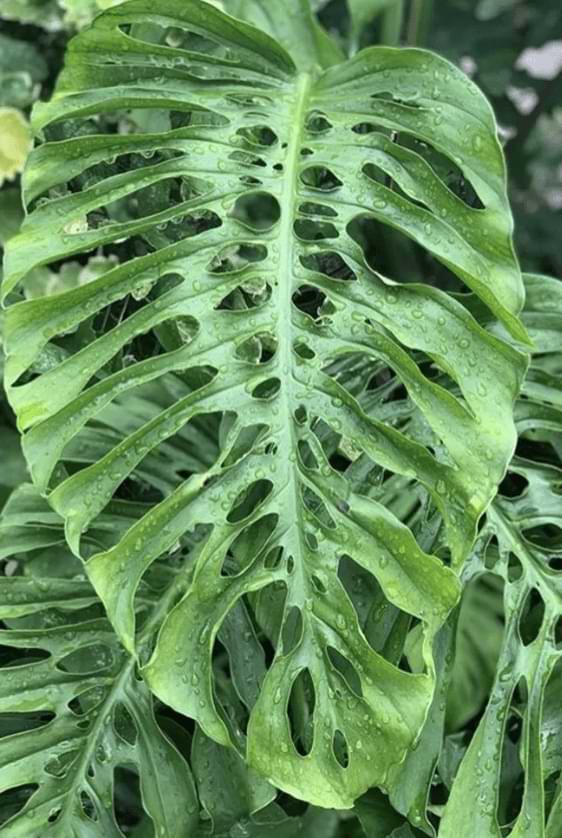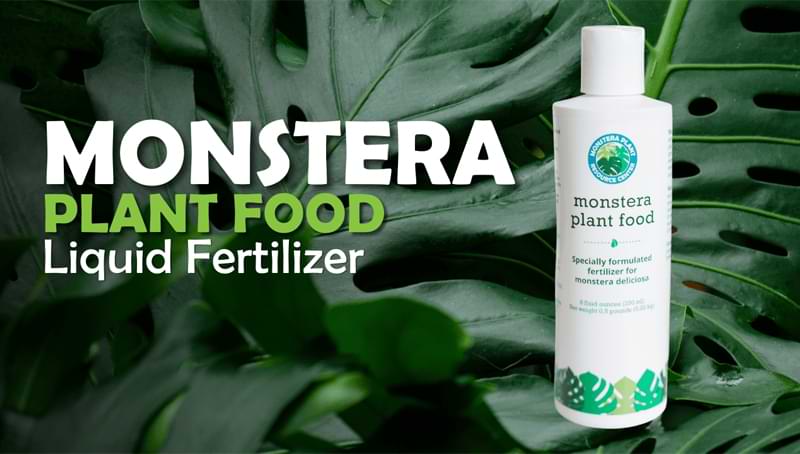The gorgeous Monstera Punctulata, with distinctively patterned leaves, is sure to turn heads and bring a touch of tropical elegance into any space. Monstera plants are just a little particular about their care, so let’s learn how to properly care for them so you can keep your plant happy and thriving!
Table of Contents
Identifying Monstera Punctulata
Identifying a Monstera Punctulata can be somewhat difficult for anyone other than Monstera experts, and understanding the differences between a juvenile and mature plant will help quite a bit.
The first place you’ll want to look in order to identify the plant is at its leaves. Juvenile Punctulata plants have smaller leaves that are shaped like an elongated heart. The first leaves of a new plant will have minimal to no fenestrations in the leaves. They are typically a deep green color with a slight sheen to the leaf, and a distinct vein down the middle of the leaf, with smaller veins branching out from the middle one to the edge of the leaf.
As the plant matures, it will develop larger, fenestrated leaves that give them their signature look. The coloring will typically stay the same, but the veining may become slightly less noticeable. The plant can also grow up to 10 feet tall inside, and even much taller if grown outdoors in its ideal environment.
The Punctulata, like other Monstera varieties, is native to the tropical rainforests of Central and South America. It thrives in warm and humid environments and enjoys filtered or indirect sunlight, making it an excellent choice for bright but not overly sunny spots in your home.
Differentiating Monstera Punctulata from its close relative, the El Salvador variety, may require paying attention to small details. While both share similar growth patterns and leaf shapes, El Salvador has thinner leaves with more pronounced holes compared to the broader leaves of Monstera Punctulata.
How to Care for Monstera Punctulata
The Punctulata is a relatively easy Monstera variety to care for, and for those experienced with other Monstera varieties, the Punctulata will not be much different. For those just entering the wonderful world of Monstera plants, there are some things to keep in mind to keep your plant happy and healthy.
Soil
This tropical beauty prefers well-draining soil that retains moisture without becoming waterlogged. A potting mix combination of peat moss, perlite, compost, and orchid bark works well for this plant. Peat moss helps retain moisture while promoting good drainage, while perlite adds airiness to the soil. The compost gives the roots more nutrients and acts as a filler, and the orchid bark provides additional structure and aids in drainage. You can also aim for a pre-made monstera-specific soil mix for your plant.
Light
Light plays a crucial role in the health and growth of Monstera Punctulata. This stunning plant thrives in bright, indirect light, making it an excellent choice for homes or offices with limited natural sunlight. However, direct sunlight can scorch its leaves, so it’s best to avoid placing it in intense sunbeams.
Water
Monsteras prefer slightly moist soil rather than being constantly wet. Overwatering can quickly lead to root rot and fungus gnat infestations. To avoid this, make sure the top inch of soil feels dry before watering again. Use a moisture meter to best determine when your plant needs to be watered again.
Temperature and Humidity
Temperature and Humidity are important for the overall health and well-being of Monstera Punctulata. This tropical plant thrives in warm environments, ideally between 65°F to 85°F. It is important to avoid sudden temperature fluctuations or exposure to cold drafts, as this can cause stress and damage its delicate leaves.
Since it is a tropical plant, the Punctulata loves a humid environment, mimicking its natural habitat. Aim for humidity levels around 50% to 60%. You can increase humidity by misting the leaves with water daily or placing the plant on a humidity tray filled with pebbles and water. Another option is using a humidifier near your plant.
Fertilizing
Providing the right nutrients will help promote healthy growth and vibrant foliage. Use a balanced plant food that is designed specifically for Monstera plants, and your Punctulata will thrive! This type of fertilizer allows your plant to receive nutrients more often and will help it use the nutrients more efficiently.
Always follow package instructions and never exceed recommended dosage as overfertilization can lead to burned roots and other issues.
Repotting
As this stunning plant grows, it may outgrow its current container and require a larger home to thrive, so eventually you will need to repot your plant. When doing this, choose a pot that is one or two inches larger than its current one. This will allow room for the roots to spread and develop properly. Make sure the new pot has drainage holes to prevent waterlogged soil, which can lead to root rot. Here are some basic steps to get you started:
- Fill your new container with fresh monstera potting soil.
- Remove your plant from its current pot.
- Clean off the roots and inspect them carefully for disease or rot (prune it off if found).
- Place your plant in the newly prepared pot, backfilling the roots until the plant is stable in its new home.
Pruning
Regular pruning helps to keep the plant healthy and promotes new growth, so it should be a regular part of caring for your plant. First, identify any dead or damaged leaves on the plant and prune them off using sharp, clean pruning shears.
In addition to removing dead leaves, you may also need to prune back overgrown vines or stems. Carefully trim these back to maintain a more compact and tidy appearance for your Monstera Punctulata.
When making cuts, always ensure that you make clean cuts just above a node – this is where new growth will emerge from. Take care not to remove too much foliage at once as this can stress the plant.
Common Problems
Even with careful attention to your plant’s care, some problems are likely to pop up anyway. Here are some of the most common problems that may affect your Monstera.
Overwatering
Overwatering can be detrimental to your plant’s health, as it prevents oxygen from getting to the roots, and creates a perfect environment for diseases to fester, harming your plant and taking its health. Some signs of overwatering are:
- Soggy soil
- Yellowing or wilting leaves
- Fungus gnats or fungus growth on the surface of the soil
To prevent this, make sure your plant has proper drainage by using a well-draining potting mix and ensuring that excess water can flow out of the bottom of the pot. If your plant is showing any of the signs above, adjust your watering schedule immediately. You may need to repot your plant to stop any potential disease from taking over your plant.
Lack of Humidity
In its native environment, this plant thrives in high humidity levels. If you live in an area with dry air or have central heating or cooling systems that reduce humidity, your Monstera Punctulata might experience some issues.
To combat this problem, you can use a humidifier near the plant or place a humidity tray filled with water and pebbles beneath it. As the water evaporates, it will create moisture in the surrounding air. You can also mist your Monstera Punctulata regularly using a spray bottle filled with water. This mimics its natural habitat where dew often forms on leaves overnight.
If you notice brown tips or edges on your plant’s leaves, it could be an indication that there’s not enough humidity. By addressing this issue promptly and providing adequate moisture for your Monstera Punctulata, you can help prevent further damage and ensure its overall health.






